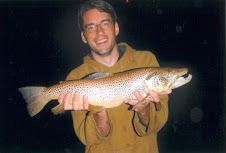So, you may ask yourself, why is the Iso my favorite bug? The answer is simple: both the volume and longevity of this particular hatch puts it squarely at the top of my list. A true size 10 at the beginning of the hatch, it is best imitated by a size 12 later on as the fish wise up. Starting in mid-June these bugs appear before the famous nighttime Hex bugs on an almost daily basis. On heavy gravel stretches of both the Au Sable and Manistee, anglers can sometimes escape the Hex madness by chasing around these bugs instead. This hatch lasts well into July, and they make a reappearance in late August and early September (usually in smaller sizes). Oh, and big fish will rise to them. Really big fish. In fact, I personally seen my dad land 2 trout near 24 inches on Isonychia patterns, and I know firsthand of a 25 incher taken last year on one by my friend Ken Mers.
They are a swimming nymph, which means that they swim onto shore, shed their nymphal shuck, and hatch on shore. This process is much different than the typical mayfly, which undergo the same insect metamorphosis only in the water instead of on land. Taking this into consideration, many people wonder why I tie the Comparadun and the Parachute in the Iso colors, as both of these style flies represent the immediate post-hatching stages of an insects life. The simple reason I tie them is that they flat out work, in all sorts of conditions.
I could tell you about days on the water landing 6 trout over 17 inches, or 50 plus trout landed on a single Iso pattern, but I won't. Instead, I urge you to look outside the box, take others advice, but also formulate your own original ideas as to how to imitate any given insect. In the case of the Isonychia bicolor , it has paid dividends for me time and time again.

These fish are the last Au Sable trout I have eaten, some five and a half years ago. The Brown at the top was the smallest of four that night, and all of the fish were caught on Isonychia parachutes.



No comments:
Post a Comment